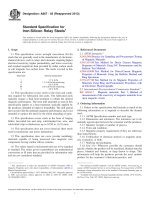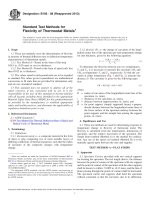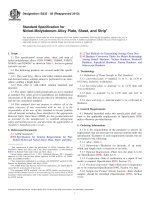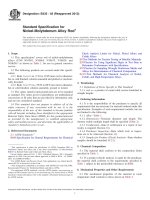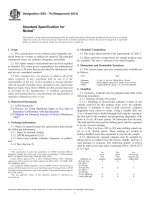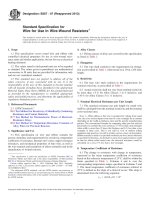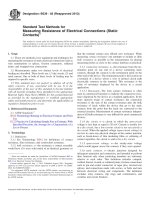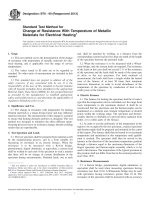Astm b 333 03 (2013)
Bạn đang xem bản rút gọn của tài liệu. Xem và tải ngay bản đầy đủ của tài liệu tại đây (79.54 KB, 3 trang )
Designation: B333 − 03 (Reapproved 2013)
Standard Specification for
Nickel-Molybdenum Alloy Plate, Sheet, and Strip1
This standard is issued under the fixed designation B333; the number immediately following the designation indicates the year of
original adoption or, in the case of revision, the year of last revision. A number in parentheses indicates the year of last reapproval. A
superscript epsilon (´) indicates an editorial change since the last revision or reapproval.
This standard has been approved for use by agencies of the Department of Defense.
E112 Test Methods for Determining Average Grain Size
E140 Hardness Conversion Tables for Metals Relationship
Among Brinell Hardness, Vickers Hardness, Rockwell
Hardness, Superficial Hardness, Knoop Hardness, and
Scleroscope Hardness
1. Scope
2
1.1 This specification covers plate, sheet, and strip of
nickel-molybdenum alloys (UNS N10001, N10665, N10675,
N10629, and N10624)* as shown in Table 1, for use in general
corrosive service.
1.2 The following products are covered under this specification:
1.2.1 Sheet and Strip—Hot or cold rolled, solution annealed,
and descaled unless solution anneal is performed in an atmosphere yielding a bright finish.
1.2.2 Plate—Hot or cold rolled, solution annealed, and
descaled.
3. Terminology
3.1 Definitions of Terms Specific to This Standard:
3.1.1 cold-rolled plate, n—material 3⁄16 to 3⁄8 in. (4.76 to
9.52 mm), inclusive, in thickness.
3.1.2 hot-rolled plate, n—material 3⁄16 in. (4.76 mm) and
over in thickness.
1.3 The values stated in inch-pound units are to be regarded
as standard. The values given in parentheses are mathematical
conversions to SI units that are provided for information only
and are not considered standard.
1.4 This standard does not purport to address all of the
safety concerns, if any, associated with its use. It is the
responsibility of the user of this standard to become familiar
with all hazards including those identified in the appropriate
Material Safety Data Sheet (MSDS) for this product/material
as provided by the manufacturer, to establish appropriate
safety and health practices, and determine the applicability of
regulatory limitations prior to use.
3.1.3 plate, n—material 3⁄16 in. (4.76 mm) and over in
thickness.
2. Referenced Documents
5.1 It is the responsibility of the purchaser to specify all
requirements that are necessary for material ordered under this
specification. Examples of such requirements include, but are
not limited to the following:
5.1.1 Alloy—Table 1,
5.1.2 Dimensions—Thickness (in decimals of an inch),
width, and length (inch or fractions of an inch),
5.1.3 Optional Requirement—Plate; how the plate is to be
cut (Specification B906, Table A2.3)
5.1.4 Certification—State if certification or a report of test
results is required (Specification B906, Section 21),
5.1.5 Purchase Inspection—State which tests or inspections
are to be witnessed (Specification B906, Section 18), and
5.1.6 Samples for Product (Check) Analysis—State whether
samples should be furnished (Specification B906, Section
7.2.2).
3.1.4 sheet and strip, n—material under 3⁄16 in. (4.76 mm) in
thickness.
4. General Requirements
4.1 Material furnished under this specification shall conform to the applicable requirements of Specification B906
unless otherwise provided herein.
5. Ordering Information
3
2.1 ASTM Standards:
B906 Specification for General Requirements for FlatRolled Nickel and Nickel Alloys Plate, Sheet, and Strip
1
This specification is under the jurisdiction of ASTM Committee B02 on
Nonferrous Metals and Alloys and is the direct responsibility of Subcommittee
B02.07 on Refined Nickel and Cobalt and Their Alloys.
Current edition approved Feb. 1, 2013. Published February 2013. Originally
approved in 1958. Last previous edition approved in 2008 as B333 – 03 (2008).
DOI: 10.1520/B0333-03R13.
* New designation established in accordance with ASTM E527 and SAE J 1086,
Practice for Numbering Metals and Alloys (UNS).
2
For ASME Boiler and Pressure Vessel Code applications, see related Specification SB-333 in Section II of that Code.
3
For referenced ASTM standards, visit the ASTM website, www.astm.org, or
contact ASTM Customer Service at For Annual Book of ASTM
Standards volume information, refer to the standard’s Document Summary page on
the ASTM website.
Copyright © ASTM International, 100 Barr Harbor Drive, PO Box C700, West Conshohocken, PA 19428-2959. United States
1
B333 − 03 (2013)
TABLE 1 Chemical Requirements
Density
Composition Limits, %
Element
Alloy
N10001
Alloy
N10665
Alloy
N10675
Nickel
remainderA remainderA 65.0 min
Molybdenum 26.0–30.0 26.0–30.0 27.0–32.0
Iron
4.0–6.0
2.0 max
1.0–3.0
Chromium
1.0 max
1.0 max
1.0–3.0
Carbon, max 0.05
0.02
0.01
Silicon, max
1.0
0.10
0.10
Cobalt, max
2.5
1.00
3.0
Manganese, 1.0
1.0
3.0
max
Phosphorus, 0.04
0.04
0.030
max
Sulfur, max
0.03
0.03
0.010
Vanadium
0.2–0.4
...
0.20 max
Nickel plus
...
...
94.0–98.0
Molybdenum
Aluminum
...
...
0.50 max
Columbium
...
...
0.20
(Nb), max
Copper, max ...
...
0.20
Tantalum,
...
...
0.20
max
Titanium,
...
...
0.20
max
Tungsten,
...
...
3.0
max
Zirconium,
...
...
0.10
max
Magnesium,
...
...
...
max
A
Alloy
N10629
Alloy
N10624
remainderA Bal
26.0–30.0 21.0-25.0
1.0–6.0
5.0-8.0
0.5–1.5
6.0-10.0
0.01
0.01
0.05
0.10
2.5
1.0
1.5
1.0
0.04
0.025
0.01
...
0.01
...
...
0.1–0.5
0.5
...
0.5
0.5
...
lb/in.3
(g/cm3)
N10001
N10665
N10675
N10629
N10624
0.334
0.333
0.333
0.333
0.322
(9.24)
(9.22)
(9.22)
(9.22)
(8.9)
8.2 Thickness:
8.2.1 Sheet and Strip—The thickness shall be measured
with the micrometer spindle 3⁄8 in. (9.525 mm) or more from
any edge for material 1 in. (25.4 mm) or over in width and at
any place on material under 1 in. (25.4 mm) in width.
8.3 Length:
8.3.1 Sheet and Strip—Sheet and strip may be ordered to cut
lengths, in which case a variation of 1⁄8 in. (3.175 mm) over the
specified length shall be permitted, with a 0 minus tolerance.
8.4 Straightness:
8.4.1 The edgewise curvature (depth of chord) of flat sheet,
strip, and plate shall not exceed 0.05 in. (1.27 mm) multiplied
by the length in feet or 0.04 mm multiplied by the length in
centimetres.
8.4.2 Straightness for coiled strip is subject to agreement
between the manufacturer and the purchaser.
...
...
...
...
Alloy
8.5 Squareness (Sheet)—For sheets of all thicknesses and
widths of 6 in. (152.4 mm) or more, the angle between adjacent
sides shall be 90 6 0.15 degrees (1⁄16 in. in 24 in. or 2.6
mm/m).
...
See Specification B906.
8.6 Flatness—Plate, sheet, and strip shall be commercially
flat.
6. Chemical Composition
6.1 The material shall conform to the composition limits
specified in Table 1.
8.7 Edges:
8.7.1 Plates shall have sheared, abrasive cut, or plasmatorch-cut edges as specified.
8.7.2 Sheet and strip shall have sheared or slit edges.
6.2 If a product (check) analysis is made by the purchaser,
the material shall conform to the requirements specified in
Table 1 and Specification B906.
9. Product Marking
9.1 Each plate, sheet, or strip shall be marked on one face
with the specification number, alloy, heat number, manufacturer’s identification, and size. The markings shall have no
deleterious effect on the material or its performance and shall
be sufficiently stable to withstand normal handling.
7. Mechanical Properties and Other Requirements
7.1 Tensile Properties—The material shall conform to the
room temperature tensile properties prescribed in Table 2.
7.2 Hardness—The hardness values given in Table 2 are
informative only.
7.3 Grain Size for Sheet and Strip—Sheet and strip shall
conform to the grain sizes as illustrated in Plate 1 of Test
Methods E112. The requirements shall be as indicated in Table
3.
9.2 Each bundle or shipping container shall be marked with
the name of the material; this specification number; alloy; the
size; gross, tare, and net weight; consignor and consignee
address; contract or order number; and such other information
as may be defined in the contract or order.
8. Dimensions, Mass, and Permissible Variations
10. Keywords
8.1 Weight—For calculations of mass or weight, the following densities shall be used:
10.1 plate; sheet; strip; UNS N10001; UNS N10629; UNS
N10665; UNS N10675; UNS N10624
2
B333 − 03 (2013)
TABLE 2 Mechanical Property Requirements
Alloy
Thickness,
in. (mm)
N10001
N10665
N10675
N10629
N10624
Under
Under
Under
Under
Under
N10001
N10665
N10675
N10629
N10624
3 16
⁄
⁄
3⁄16
3⁄16
3⁄16
3 16
⁄
⁄
3⁄16
3⁄16
3⁄16
3 16
3 16
Yield Strength
(0.2 % Offset),
min, psi (MPa)
Tensile Strength,
min, psi (MPa)
Sheet and Strip
115 000 (795)
110 000 (760)
110 000 (760)
110 000 (760)
104 000 (720)
Plate
100 000 (690)
110 000 (760)
110 000 (760)
110 000 (760)
104 000 (720)
(4.76)
(4.76)
(4.76)
(4.76)
(4.76)
to 21⁄2 in. (4.76 to 63.5 mm), incl
to 21⁄2 in. (4.76 to 63.5 mm), incl
to 21⁄2 in. (4.76 to 63.5 mm), incl
to 21⁄2 in. (4.76 to 63.5 mm), incl
to 21⁄2 in. (4.76 to 63.5 mm), incl
Elongation
in 2 in.
(50.8 mm)
or 4DA
min, %
Rockwell
Hardness,B
max
50
51
51
51
46
000
000
000
000
000
(345)
(350)
(350)
(350)
(320)
45
40
40
40
40
100
100
100
100
100
HRB
HRB
HRB
HRB
HRB
45
51
51
51
46
000
000
000
000
000
(310)
(350)
(350)
(350)
(320)
40
40
40
40
40
100
100
100
100
100
HRB
HRB
HRB
HRB
HRB
A
D refers to the diameter of the tension specimen.
Hardness values are shown for information purposes only and are not to be used as a basis for rejection or acceptance. For approximate hardness conversions, see
Hardness Conversion Tables E140.
B
TABLE 3 Grain Size for Annealed Sheet
Thickness,
in. (mm)
0.125 (3.175) and under
Over 0.125 (3.175)
ASTM Micrograin
Size Number,
max
3.0
1.5
Average Grain
Diameter, max,
mm (in.)
0.127 (0.0050)
0.214 (0.0084)
APPENDIX
(Nonmandatory Information)
X1. HEAT TREATMENT
X1.1 Proper heat treatment during or subsequent to fabrication is necessary for optimum performance, and the manufacturer shall be consulted for details.
ASTM International takes no position respecting the validity of any patent rights asserted in connection with any item mentioned
in this standard. Users of this standard are expressly advised that determination of the validity of any such patent rights, and the risk
of infringement of such rights, are entirely their own responsibility.
This standard is subject to revision at any time by the responsible technical committee and must be reviewed every five years and
if not revised, either reapproved or withdrawn. Your comments are invited either for revision of this standard or for additional standards
and should be addressed to ASTM International Headquarters. Your comments will receive careful consideration at a meeting of the
responsible technical committee, which you may attend. If you feel that your comments have not received a fair hearing you should
make your views known to the ASTM Committee on Standards, at the address shown below.
This standard is copyrighted by ASTM International, 100 Barr Harbor Drive, PO Box C700, West Conshohocken, PA 19428-2959,
United States. Individual reprints (single or multiple copies) of this standard may be obtained by contacting ASTM at the above
address or at 610-832-9585 (phone), 610-832-9555 (fax), or (e-mail); or through the ASTM website
(www.astm.org). Permission rights to photocopy the standard may also be secured from the ASTM website (www.astm.org/
COPYRIGHT/).
3
